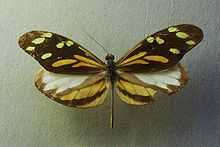Dismorphia amphione
| Dismorphia amphione | |
|---|---|
| | |
| Scientific classification | |
| Kingdom: | Animalia |
| Phylum: | Arthropoda |
| Class: | Insecta |
| Order: | Lepidoptera |
| Family: | Pieridae |
| Genus: | Dismorphia |
| Species: | D. amphione |
| Binomial name | |
| Dismorphia amphione (Cramer, [1779])[1] | |
| Synonyms | |
| |
The Tiger Mimic White (Dismorphia amphione) is a species of butterfly of the Pieridae family. It is found from Mexico and the Caribbean down to Brazil and Bolivia.
The wingspan is about 77 mm. It is an extremely variable species.[2]
The larvae feed on Inga species, including Inga sapindoides and Inga densiflora.
Dismorphia amphione mimics the ithomiine Mechanitis lysimnia Fabricius in colour pattern and in the slow regular flight.[3]
Subspecies
- Dismorphia amphione amphione (Surinam)
- Dismorphia amphione astynome (Dalman, 1823) (Brazil (São Paulo, Bahia, Minas Gerais), Argentina)
- Dismorphia amphione praxinoe (Doubleday, 1844) (Mexico, from Panama to Colombia)
- Dismorphia amphione beroe (Lucas, 1852) (Colombia)
- Dismorphia amphione egaena (Bates, 1861) (Brazil (Amazonas))
- Dismorphia amphione discrepans Butler, 1896 (Ecuador)
- Dismorphia amphione rhomboidea Butler, 1896 (Ecuador, Peru)
- Dismorphia amphione broomeae Butler, 1899 (Venezuela, Trinidad)
- Dismorphia amphione meridionalis Röber, 1909 (Bolivia)
- Dismorphia amphione daguana Bargmann, 1929 (Colombia)
- Dismorphia amphione lupita Lamas, 1979 (Mexico)
- Dismorphia amphione isolda Llorente, 1984 (Mexico)
- Dismorphia amphione bertha Lamas, 2004 (Peru)
- Dismorphia amphione mora Lamas, 2004 (Peru)
Gallery
-
Dismorphia amphione amphione Male
-
Dismorphia amphione amphione Female
-
Dismorphia amphione discrepans Male
-
Dismorphia amphione discrepans Female
-
Dismorphia amphione astynome Male
-
Dismorphia amphione astynome Female
-

Dismorphia amphione praxinoe Male
-

Dismorphia amphione praxinoe Female
References
- ↑ Dismorphia at funet
- ↑ Butterflies of the Sangay National Park
- ↑
- Kassarov, L. 2001 (2004). Is aposematism a valid concept in predator-prey relationships between birds and butterflies? A different point of view. Tropical Lepidoptera 12(1-2): 1-15. pdf Abstract: The concept of aposematism, especially in regard to butterflies, is discussed in terms of the close interrelationship between butterflies, as prey, and birds, as their predators, in their common environment. Vision, in a broad sense, and especially in terms of the visual capabilities of the avian eye, is discussed as a basis for understanding the difference between the aerial hawker insectivorous bird predators of butterflies, and all other birds, regardless of whether considered primarily insectivorous or not. The marked differences in foraging behavior determine how a bird perceives the bright color patterns of butterflies. For aposematic color patterns to be effective, they have to be seen by the bird as an optical device advertising distasteful or toxic qualities of the potential prey so that the predator avoids them by sight. It is argued here that birds that prey on butterflies do not perceive them as an aposematic insect, as postulated by the concept of aposematism. The bird does not reject a butterfly on the basis of color pattern, but on the basis of characteristic morphological and behavioral patterns which provide the bird with a signal as to whether the butterfly is energetically profitable or unprofitable for the bird as a food source.